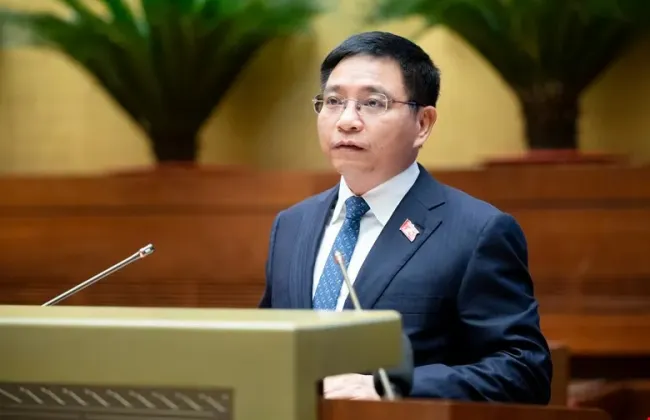Today (November 13), the National Assembly listened to the presentation and review report on the investment policy for the high-speed railway project on the North-South axis.
Shortest, straightest route possible
On behalf of the Government, Minister of Transport Nguyen Van Thang presented a proposal. Accordingly, the Government proposed to build a new double-track railway line, 1,435 mm gauge, electrification, design speed 350 km/h, load capacity 22.5 tons/axle; main line length about 1,541 km with 23 passenger stations, 5 freight stations.
The North-South high-speed railway serves passenger transport, meets dual-use requirements for national defense and security, and can transport goods when necessary.
The route in the proposal has been agreed upon by 20/20 provinces and cities with high-speed railway lines passing through. Specifically, through Hanoi, Ha Nam, Nam Dinh, Ninh Binh, Thanh Hoa, Nghe An, Ha Tinh, Quang Binh, Quang Tri, Thua Thien – Hue, Da Nang, Quang Nam, Quang Ngai, Binh Dinh, Phu Yen, Khanh Hoa, Ninh Thuan, Binh Thuan, Dong Nai, Ho Chi Minh City.

Regarding the station construction, the project proposes to arrange 23 passenger stations and 5 freight stations. The Ministry of Transport said that the principle of selecting stations is to be consistent with current conditions and local development planning, especially in locations with large enough transportation demand.
Each province arranges 1 station to access the central urban area, urban planning area with development potential, ensuring good connectivity with the national transport system, especially the national railway system and public transport.
Regarding the project implementation progress, it is expected to submit the investment policy to the National Assembly for approval in the fourth quarter of 2024; complete the preparation and approval of the Feasibility Study Report and Front-End Engineering Design (FEED) in 2025-2026; carry out site clearance, bid to select contractors, start the project in 2027 and strive to basically complete the entire route by 2035.
The total preliminary investment of the project is about 1.7 quadrillion VND (about 67.34 billion USD), the project investment rate is about 43.7 million USD/km. To successfully implement and complete the entire project as scheduled, the project proposes 19 specific and special policies.
The overall budget balance needs to be carefully calculated.
Examining this content, the Economic Committee proposed that in the feasibility study step, the Government direct relevant agencies to carefully review and select the optimal option to connect the high-speed railway line with the national railway network, urban railway, other transport systems and with the regional and international railway network.
The Economic Committee also requested clarification of the calculation basis for the forecast of transport demand of the Project, when in fact, in the past, the forecast of transport demand of many BOT transport projects had a large difference compared to reality, leading to ineffectiveness in financial plans and requiring adjustments to project contracts.

Regarding the total investment of 67.34 billion USD of the project, the Economic Committee said that the Government’s submission and accompanying documents have not clearly shown the investment phases and the expected specific capital in each phase.
“This is an important content that requires coordination between relevant ministries and agencies to develop a capital allocation plan to ensure feasibility,” emphasized Chairman of the Economic Committee Vu Hong Thanh.
Regarding public debt safety, according to the Economic Committee, the submission and accompanying documents affirm that the three criteria of public debt, government debt and foreign debt of the country are within the allowable limit. However, the Economic Committee believes that the two important criteria are the average state budget deficit and direct debt payment, which are expected to increase at a fairly high level.
“Many opinions say that our country’s budget in the past and in the coming years will still be in deficit, with public investment capital mainly coming from loans. Therefore, the overall budget balance needs to be carefully calculated to ensure macroeconomic stability,” said Mr. Thanh.
According to the Economic Committee, in the context of recent years, debt repayment and public debt have tended to increase, the Government’s direct debt repayment obligation in 2025 is about 24% of the State budget revenue, close to the allowable ceiling (25%).
Therefore, it is recommended that the Government specifically assess the impact of project investment on the State budget deficit, public debt, and the State budget’s ability to repay debt in the medium and long term. Strictly adhere to the principles of public debt safety indicators to ensure national financial security and not put pressure on debt repayment in the following stages.
















